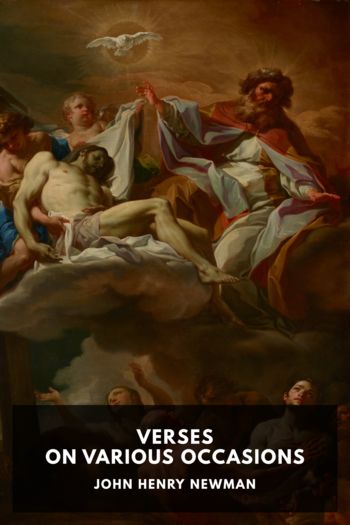Don Quixote, Miguel de Cervantes Saavedra [reading well .txt] 📗

- Author: Miguel de Cervantes Saavedra
Book online «Don Quixote, Miguel de Cervantes Saavedra [reading well .txt] 📗». Author Miguel de Cervantes Saavedra
In 1687 John Phillips, Milton’s nephew, produced a Don Quixote “made English,” he says, “according to the humour of our modern language.” His Quixote is not so much a translation as a travesty, and a travesty that for coarseness, vulgarity, and buffoonery is almost unexampled even in the literature of that day.
Ned Ward’s Life and Notable Adventures of Don Quixote, Merrily Translated Into Hudibrastic Verse (1700), can scarcely be reckoned a translation, but it serves to show the light in which Don Quixote was regarded at the time.
A further illustration may be found in the version published in 1712 by Peter Motteux, who had then recently combined tea-dealing with literature. It is described as “translated from the original by several hands,” but if so all Spanish flavour has entirely evaporated under the manipulation of the several hands. The flavour that it has, on the other hand, is distinctly Franco-cockney. Anyone who compares it carefully with the original will have little doubt that it is a concoction from Shelton and the French of Filleau de Saint Martin, eked out by borrowings from Phillips, whose mode of treatment it adopts. It is, to be sure, more decent and decorous, but it treats Don Quixote in the same fashion as a comic book that cannot be made too comic.
To attempt to improve the humour of Don Quixote by an infusion of cockney flippancy and facetiousness, as Motteux’s operators did, is not merely an impertinence like larding a sirloin of prize beef, but an absolute falsification of the spirit of the book, and it is a proof of the uncritical way in which Don Quixote is generally read that this worse than worthless translation—worthless as failing to represent, worse than worthless as misrepresenting—should have been favoured as it has been.
It had the effect, however, of bringing out a translation undertaken and executed in a very different spirit, that of Charles Jervas, the portrait painter, and friend of Pope, Swift, Arbuthnot, and Gay. Jervas has been allowed little credit for his work, indeed it may be said none, for it is known to the world in general as Jarvis’s. It was not published until after his death, and the printers gave the name according to the current pronunciation of the day. It has been the most freely used and the most freely abused of all the translations. It has seen far more editions than any other, it is admitted on all hands to be by far the most faithful, and yet nobody seems to have a good word to say for it or for its author. Jervas no doubt prejudiced readers against himself in his preface, where among many true words about Shelton, Stevens, and Motteux, he rashly and unjustly charges Shelton with having translated not from the Spanish, but from the Italian version of Franciosini, which did not appear until ten years after Shelton’s first volume. A suspicion of incompetence, too, seems to have attached to him because he was by profession a painter and a mediocre one (though he has given us the best portrait we have of Swift), and this may have been strengthened by Pope’s remark that he “translated Don Quixote without understanding Spanish.” He has been also charged with borrowing from Shelton, whom he disparaged. It is true that in a few difficult or obscure passages he has followed Shelton, and gone astray with him; but for one case of this sort, there are fifty where he is right and Shelton wrong. As for Pope’s dictum, anyone who examines Jervas’s version carefully, side by side with the original, will see that he was a sound Spanish scholar, incomparably a better one than Shelton, except perhaps in mere colloquial Spanish. He was, in fact, an honest, faithful, and painstaking translator, and he has left a version which, whatever its shortcomings may be, is singularly free from errors and mistranslations.
The charge against it is that it is stiff, dry—“wooden” in a word—and no one can deny that there is a foundation for it. But it may be pleaded for Jervas that a good deal of this rigidity is due to his abhorrence of the light, flippant, jocose style of his predecessors. He was one of the few, very few, translators that have shown any apprehension of the unsmiling gravity which is the essence of quixotic humour; it seemed to him a crime to bring Cervantes forward smirking and grinning at his own good things, and to this may be attributed in a great measure the ascetic abstinence from everything savouring of liveliness which is the characteristic of his translation. In most modern editions, it should be observed, his style has been smoothed and smartened, but without any reference to the original Spanish, so that if he has been made to read more agreeably he has also been robbed of his chief merit of fidelity.
Smollett’s version, published in 1755, may be almost counted as one of these. At any rate it is plain that in its construction Jervas’s translation was very freely drawn upon, and very little or probably no heed given to the original Spanish.
The later translations may be dismissed in a few words. George Kelly’s, which appeared in 1769, “printed for the Translator,” was an impudent imposture, being nothing more than Motteux’s version with a few of the words, here and there, artfully transposed; Charles Wilmot’s (1774) was only an abridgment like Florian’s, but not so skilfully executed; and the version published by Miss Smirke in 1818, to accompany her brother’s plates, was merely a patchwork production made out of former translations. On the latest, Mr. A. J. Duffield’s, it would be in every sense of the word





Comments (0)